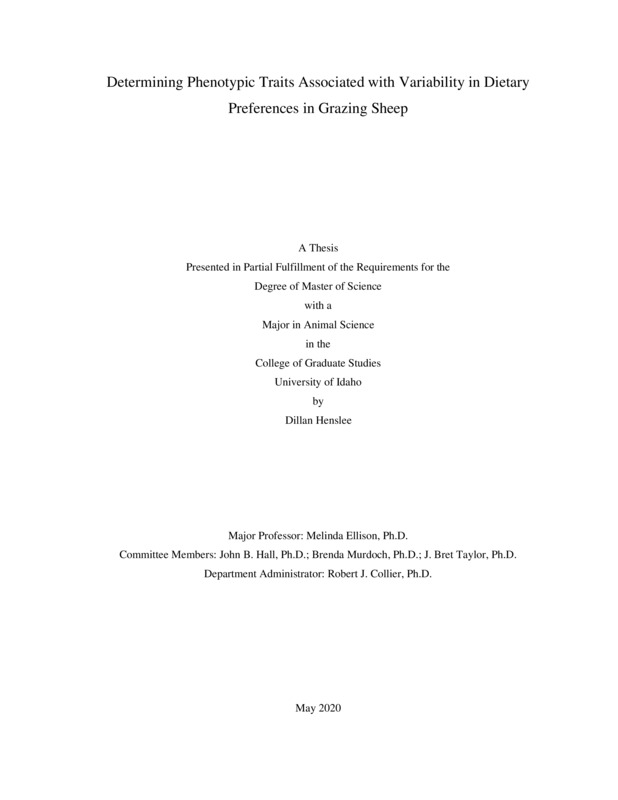Determining Phenotypic Traits Associated with Variability in Dietary Preferences in Grazing Sheep
Henslee, Dillan. (2020-05). Determining Phenotypic Traits Associated with Variability in Dietary Preferences in Grazing Sheep. Theses and Dissertations Collection, University of Idaho Library Digital Collections. https://www.lib.uidaho.edu/digital/etd/items/henslee_idaho_0089n_11722.html
- Title:
- Determining Phenotypic Traits Associated with Variability in Dietary Preferences in Grazing Sheep
- Author:
- Henslee, Dillan
- Date:
- 2020-05
- Keywords:
- Bitterness Diet Preferences Sagebrush Sheep Tas2r
- Program:
- Animal and Veterinary Science
- Subject Category:
- Animal sciences; Range management
- Abstract:
-
Sheep have the potential to be used globally as a grazing tool on rangelands for wildlife habitat improvement. Dietary preferences within sheep, especially preferences for consuming sagebrush, vary greatly. This thesis explores driving factors that could help explain variation in dietary preferences in sheep. We first examined bitterness avoidance in sheep by administering a gradient of concentrations of phenylthiocarbamide (PTC) dissolved in drinking water and quantifying individual intake in rams. We observed that sheep could detect PTC and that there was considerable variation in the concentrations at which PTC was avoided among sheep. These observations were similar to PTC avoidance described in humans, which has been attributed to genetic variations within type two taste receptors (Tas2r). Sheep have Tas2r genes, but due to the incomplete annotation of sheep Tas2r gene repertoire, extensive research studies correlating sheep Tas2r genes with phenotypic traits cannot be conducted. Using comparative genomic strategies, we proposed annotations for each of the non-annotated Tas2r genes in sheep, cattle and goat in order to complete the annotation of grazing livestock Tas2r repertoires. With the completed Tas2r repertoire of sheep, we will be able to continue our research with an extensive genetic study that may later be associated with dietary preferences in sheep. Taken altogether, the data from this research suggests that sheep can detect bitterness, which is likely a function of Tas2r genetic makeup and may be linked to sagebrush consumption. Better understanding of factors that contribute to dietary preferences in sheep could lead to selection for individuals that are uniquely suited for targeted grazing strategies that allow for sustainable grazing and dynamic wildlife habitat in sagebrush-steppe ecosystems.
- Description:
- masters, M.S., Animal and Veterinary Science -- University of Idaho - College of Graduate Studies, 2020-05
- Major Professor:
- Ellison, Melinda
- Committee:
- Murdoch, Brenda ; Hall, John ; Taylor, J. Bret
- Defense Date:
- 2020-05
- Identifier:
- Henslee_idaho_0089N_11722
- Type:
- Text
- Format Original:
- Format:
- application/pdf
- Rights:
- In Copyright - Educational Use Permitted. For more information, please contact University of Idaho Library Special Collections and Archives Department at libspec@uidaho.edu.
- Standardized Rights:
- http://rightsstatements.org/vocab/InC-EDU/1.0/

